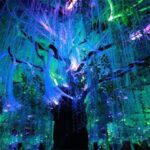The Shanghai Museum of Glass Art is located near Tianzifang. The predecessor of the museum is the Shanghai Watch Plastic Parts Factory. After reinforcement and renovation, this brick building that has endured fifty years of wind, frost, snow and rain is presented to people again in the appearance of a beautiful glass building. Although the museum is not large in area, both the exterior wall and the roof are full of design.
The single exterior wall is inlaid with more than 4,800 transparent glass bricks with a texture like grotto rocks. A giant golden peony flower 10 meters wide, 5 meters high and weighing 1 ton is hung high on the glass wall, as if blooming from the glass, which is particularly eye-catching. Especially at night, the glass wall becomes colorful under the illumination of lights, just like a beautiful work of art. The museum is themed with glass exhibits and has three floors. The first floor is LCM Café and the museum gift shop for people to rest and relax or buy glass gifts. The exhibition area on the second floor exhibits ancient Chinese glass series, masterpieces of world glass masters, and new works of 10 modern glass artists in the international glass field. The works on the third floor are the representative works of Yang Huishan, an artist of Liuli Workshop and the founder of Liuli Workshop. It is amazing that the Guanyin statue of “Great Wish in This Life” which took 10 years to create. This three-dimensional restoration work derived from the Yuan Dynasty murals in Mogao Grottoes in Dunhuang is up to 4.5 meters in total. It is the only work in the museum that is not made of glass and is worth seeing. From March 17th, the Shanghai Museum of Glass Art ushered in the first art exhibition of 2021 – the international glass art exhibition “WHY GLASS? Exploring Life and Emotion with LIULI”. The international glass art series exhibition “WHY GLASS” held many times by the Shanghai Museum of Glass Art has become a beautiful landscape of glass art in Shanghai due to its wide acclaim. The artworks in the series exhibition are the collection and essence of Zhang Yi and Yang Huishan, the founders of the museum for many years, connecting the poetic development context of glass art. From the vigorous American studio glass movement to the contemporary Asian glass art containing oriental culture, it builds a comprehensive development history of modern and contemporary glass art for professionals and enthusiasts. This exhibition specially exhibits the series works “Boat Series” and “Clear Cube” of Steven Weinberg, a representative artist of the American studio glass movement. Steven Weinberg, known as the master of American glass casting, has held more than 200 exhibitions worldwide, and more than 30 museums around the world have collected his glass artworks.Steven Weinberg is the first international glass artist invited after the establishment of the Shanghai Museum of Glass Art. Amidst the tumultuous studio glass movement of the 1980s, where the glass art world emphasized rich colors and the free shaping of blown glass, Weinberg embarked on his exploration within the transparent inner space, alone. Through his creations, Weinberg has transformed glass into an artistic medium, achieving an internal tension that congeals time, displaying a tranquility transcending time and space, and conveying an incredible viewing experience to visitors.
Life is so chaotic and uncontrollable; I try to find harmony in this disorderly world. In the process of creation, I find that tranquility. Through the process of making objects, I am able to set parameters and make sense of space, whereas my day-to-day life borders on unmanageable chaos. I find peace in the process of making art juxtaposed to the uncertainty of everyday living. —— Steven Weinberg The ‘Cube’ on display at the scene is one of Steven Weinberg’s representative works. Unique artistic ideas and techniques, the combination of external shaping and internal light and shadow, lead visitors into the solidified time and space constructed by the artist. The ‘Boat’ series, on the other hand, marks another high-level breakthrough, turning every curve of the work into a unity of flow and congelation. The bubbles inside the glass endow the work with an extremely dreamy quality. Weinberg’s ‘Boat’ series is like a seemingly calm journey of life, causing huge waves in an instant and stopping in a moment, demonstrating the static beauty of glass art with strong internal momentum. ‘WHY GLASS? Exploring Life and Emotion with LIULI’ – the international glass art exhibition showcases representative works of twelve modern international glass art masters. These include the first person in glass art: Émile Gallé; French modern inheritors and revivers of lost wax casting Almaric Walter and François Décorchemont; French modern national treasure glass art master Antoine Leperlier; several artists involved in the studio glass movement such as Ann Wolff, Jay Musler, Kyohei Fujita, Paul Stankard, and Steven Weinberg; and French new generation glass representative artists Lise Gonthier and Gérald Vatrin.
This international glass art exhibition spans a century of time and space and presents many wonderful works. Let the colorful glass artworks showcase the unique humanistic emotions and life explorations of artists.

Exhibition location: Shanghai Museum of Glass Art (No. 25 Taikang Road, Huangpu District, Shanghai).

Opening hours: From January 1st to October 6th, closed all day on Mondays; from October 9th to December 31st, closed all day on Mondays; from January 1st to October 6th, open from 10:00 to 17:00 on Tuesdays to Sundays; from October 9th to December 31st, open from 10:00 to 17:00 on Tuesdays to Sundays; closed all day on October 8th; open from 10:00 to 17:00 on October 7th.









